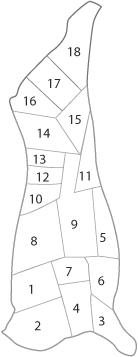
click products image for more info
General
A beef carcass is divided into four main sections, two forequarters and two hindquarters. These are normally divided btween the tenth and eleventh rib bone.
Forequarters >
Hindquarters >
Forequarters
Very often it is a lack of knowledge regarding the correct cooking methods for the different cuts that causes the versatility of the forequarter to be underestimated. Because the forequarter contains about 2-4% more bones and white connective tissue, it is far tastier, although less tender. The percentage of fat in the fore and hindquarters is nearly the same.
Primary cuts
- 1. Chuck, Hump
- 2. Neck
- 3, 18. Shin
- 4. Bolo
- 5. Brisket
- 6. Brisket
- 7. Flat rib
- 8. Prime rib
- 9. Short rib
Hindquarters
The hindquarter contains more tender cuts that may be prepared by means of dry-heat cooking methods. The hindquarters is from where delicious steak are cut.
Primary cuts
- 10. Sirloin
- 11. Thin flank
- 12. Fillet
- 13. Striploin
- 14. Rump
- 15. Thick flank
- 16. Rump
- 17. Silverside, Topside
1. Chuck, Hump
The chuck consists of six backbone vertebrae sawn through, six to seven ribs, the shoulder blade, dorsel vertebrae, yellow connective tissue (elastin) and several smaller muscles which run in different directions. The texture varies from coarse to fine and so does the degree of tenderness. The breed and the species normally determines size of this boneless cut.
The Hump is a boneless cut that varies in size according to breed and the species and contains abundant intramuscular fat (marbling)

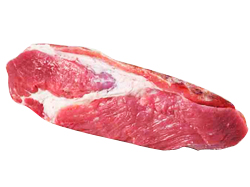
2. Neck
Contains a large proportion of bone and white connective tissue and is therefor very tasty. Also contains a thick yellow sinew, (yellow connective tissue or elastine), remove before cooking as it will not soften.

3. Shin
Contains a large proportion of bone and white connective tissue which makes this a tough but tasty cut.

4. Bolo
The Bolo is charactised by the bright red muscle layer (red fkeck on tfat layer) on top. It is a boneless cut witha coarse texture and consists of several muscle layers which run in different directions, The bolo contains very little intramuscular fat. The different layers can be seperated by following the natural seams.
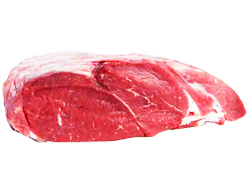
5. Brisket
This flavoursome cut with a coarse texture contains the breastbone and a few ribs. The brisket can be divided into the point brisket, middle caut and plate.
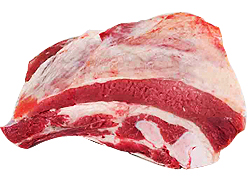
6. Brisket
This flavoursome cut with a coarse texture contains the breastbone and a few ribs. The brisket can be divided into the point brisket, middle caut and plate.

7. Flat rib
This cut contains ribs with two thin muscle layers separated by a layer of connective tissue and fat.
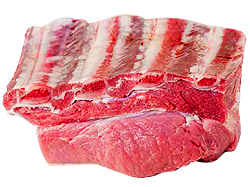
8. Prime rib
The prime rib consists of the dorsel vertebrae, backbone vertebrae, three ribs, the large eye muscle, smaller muscle layers and an even layer of fat.
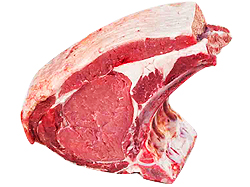
9. Shortribs
Famous for it's T-bone steaks, this cut is tender with a fine texture, The T-bone, Porterhouse and fillet steaks and strip loin are great when grilled or pan-fried. The roll makes a great oven roast or braai.
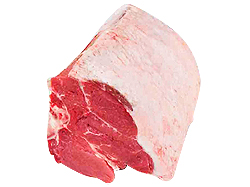
10. Sirloin
Similiar to prime rib, makes great oven roasts and steaks.

11. Thin Flank
The flank consists of a boneless section and a few ribs known as short rib. The whole cut is covered with a thick layer of connective tissue which must be removed before cooking
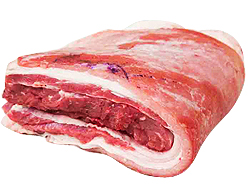
12. Fillet
The fillet, situated inside the carcase alonside the backbone and protected by the layer of kidney fat runs from the sirloin to the rump. The fillet becomes larger towards the rump. This meat cut is boneless, almost without fat and the most tender cut of the carcase.
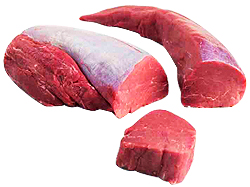
13. Striploin
The breed and the species normally determines size of this boneless cut. The coarse texture is well marbled and very tasty

14. Rump
The rump consists of several loose muscle layers and the largs pelvic bone. A section of the fillet is also situated ib the rump.
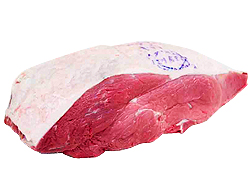
15. Thick Flank
The thick flank consists of the three muscles. The inner muscle also known as the mock filler is the most tender.
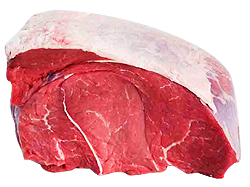
16. Rump
The breed and the species normally determines size of this boneless cut. The coarse texture is well marbled and very tasty

17. Silverside, Topside
The breed and the species normally determines size of this boneless cut. The coarse texture is well marbled and very tasty
A characteristic feature of this cut is the thick half moon-shaped fat layer. Just below the fat layer is a thin flat muscle and below that two thicker muscle layers. The topside is boneless.
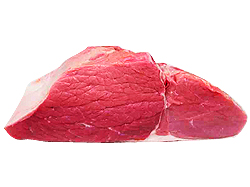
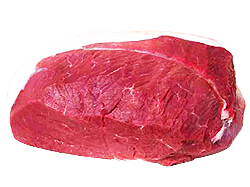
18. Shin
Contains a large proportion of bone and white connective tissue which makes this a tough but tasty cut.
